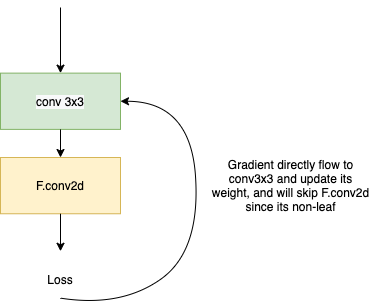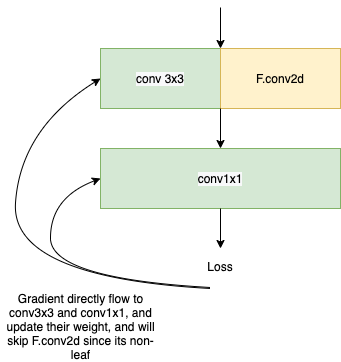Below is a simple reproducible code snippet:
I know this might be a simple question, but I never thought of it before and just want to confirm here.
import torch
import torch.nn as nn
import torch.nn.functional as F
import torch.optim as optim
class Net(nn.Module):
def __init__(self):
super(Net, self).__init__()
self.conv = nn.Conv2d(1,1,3, padding=1, bias=False)
self.weight1 = self.conv.weight * 10
def forward(self, x):
out = self.conv(x)
out2 = F.conv2d(out, self.weight1, padding=1)
return out2
then during back-propagation, I noticed that self.weight1 will not be updated.
net = Net()
# -> checkpoint 1: print(net.conv1.weight, net.weight1)
optimizer1 = optim.SGD(net.parameters(), lr=0.001)
Loss1 = nn.L1Loss()
k = torch.ones((1,1,5,5))
gt = torch.zeros((1,1,5,5))
# back propagation
optimizer1.zero_grad()
pred = net(k)
loss1 = Loss1(gt, pred)
loss1.backward()
optimizer1.step()
# -> checkpoint 2: print(net.conv1.weight, net.weight1)
for the above 2 checkpoints, the outputs are below:
# checkpoint 1: print(net.conv1.weight, net.weight1)
Parameter containing:
tensor([[[[ 0.1280, 0.1039, -0.1972],
[-0.2293, 0.1194, -0.1370],
[-0.3182, -0.1437, 0.0395]]]], requires_grad=True)
tensor([[[[ 1.2796, 1.0391, -1.9720],
[-2.2928, 1.1938, -1.3697],
[-3.1816, -1.4372, 0.3954]]]], grad_fn=<MulBackward0>)
# checkpoint 2: print(net.conv1.weight, net.weight1)
Parameter containing:
tensor([[[[ 0.1337, 0.1111, -0.1900],
[-0.2223, 0.1278, -0.1290],
[-0.3123, -0.1371, 0.0456]]]], requires_grad=True)
tensor([[[[ 1.2796, 1.0391, -1.9720],
[-2.2928, 1.1938, -1.3697],
[-3.1816, -1.4372, 0.3954]]]], grad_fn=<MulBackward0>)
you can see self.weight1 in network does not get updated. but self.weight1 is a torch.tensor and it has a gradient, i.e. net.weight1.requires_grad is True. This is because self.weight1 is a non-leaf tensor.
This is not my confusion, my question is, since self.weight1 is not get updated, does that mean, the gradients from loss directly propagate to self.conv, because the layer F.conv is not learning(i.e. because F.conv is not part of the graph)?
Really appreciate if anyone can give me some hints.

